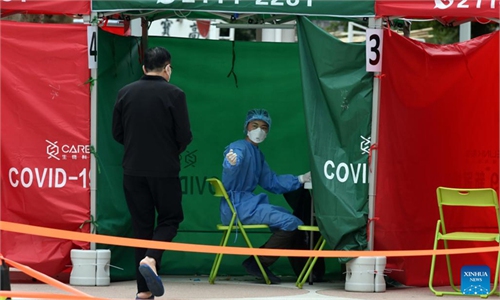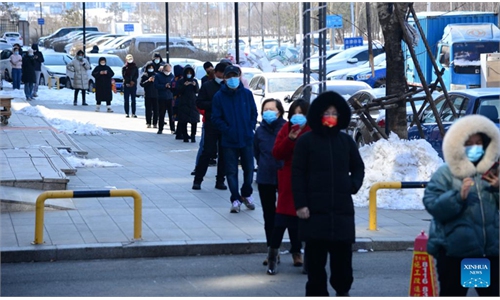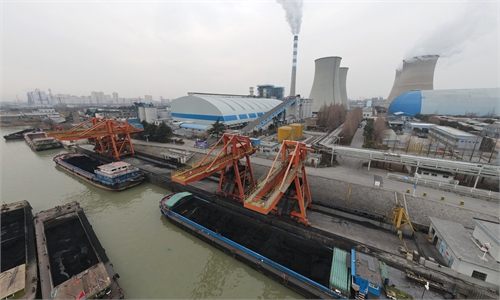China's tech hub among first to curb Omicron spread amid nationwide outbreaks, showing effectiveness of dynamic zero-COVID policy
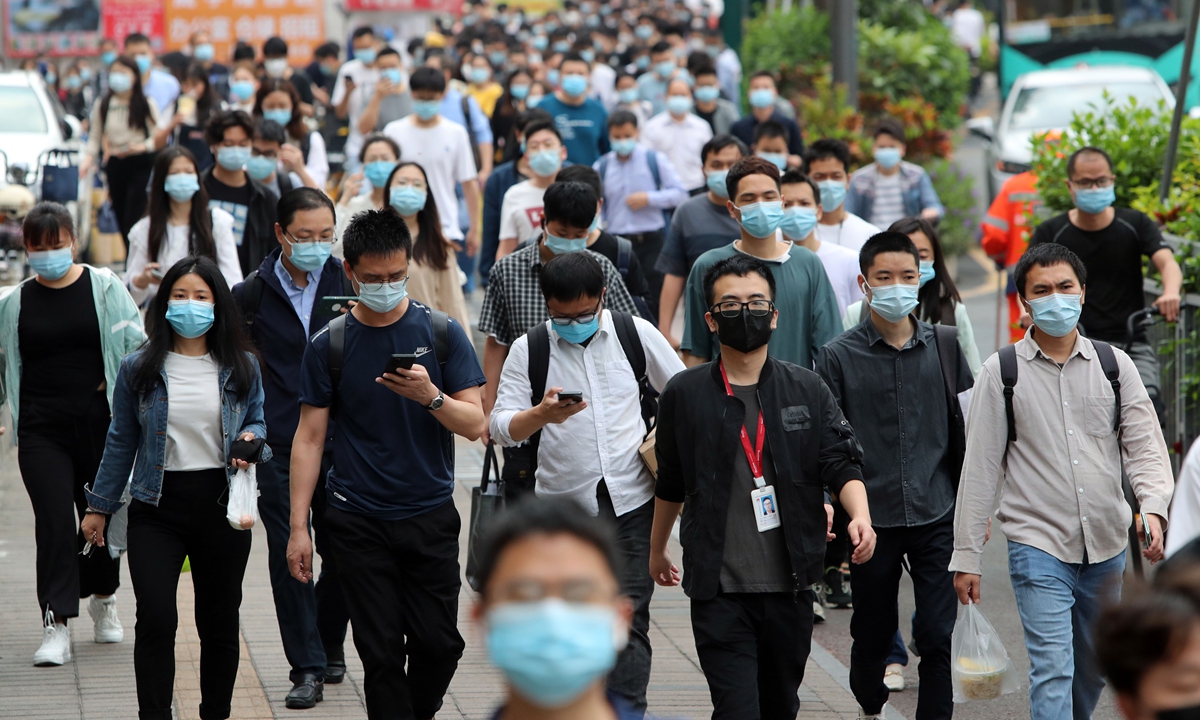
People walk into a hi-tech park in Shenzhen on March 21, 2022, the day when the city resumed production, business and public transport after a week of restrictive measures to quickly curb the COVID-19 resurgence. Photo: Xinhua
Shenzhen, China's Silicon Valley and one of the 28 provinces and regions in China hit by the Omicron variant in the latest outbreak, has returned to a normal busy hi-tech hub on Monday after seven days of strict prevention and control measures that included placing all residential communities under closed management, suspending public transportation and closing stores and businesses.
As one of the first Chinese cities to step out of the fresh wave of a domestic COVID-19 outbreak, Shenzhen's practice of unwaveringly sticking to the dynamic zero COVID-19 policy and striking a right balance between epidemic control and economy in the battle against Omicron has not only injected strong confidence in the nation's Omicron battle, but was also a powerful response to some Western media's smears and doubts of China's COVID-19 strategy which they believe was under great threat due to the fast spread of the variant.
On Monday morning, life in Shenzhen, China's fastest growing city, largely returned to normal with factories and offices reopened, and many local residents carried their desktop computers and keyboards in the subway in the morning rush hour, after the city's 17 million residents completed three rounds of nucleic acid testing.
Shenzhen reported 44 new domestically-transmitted cases on Sunday, with most found among close contacts in quarantine and two found in communities. The number of daily new positive cases found in communities has dropped from the highest 38 to one or two over a week.
The Shenzhen government announced that apart from some areas in Futian district which still reported community infections, most of the city would resume work and production activities on Monday and implement "differentiated" anti-epidemic measures for different enterprises to ensure the safety and stability of industrial and supply chains.
The awareness of "maximizing prevention and control effects at the lowest cost" has been deeply rooted in local residents as they would like to voluntarily cooperate with the implementation of dynamic zero policy in exchange for long-term social and economic development.
With most imported cases coming from neighboring Hong Kong Special Administrative Region, which is struggling with a fifth wave of outbreak, Shenzhen took resolute measures to guard against the risks of imported infections and further spread, including crackdown on illegal crossing, which set an fine example for other port cities, expert said.
Experts believe China will stick to its dynamic zero-COVID policy, and the policy is likely to be adjusted when the public reaches herd immunity through more effective vaccines and COVID-19 drugs.
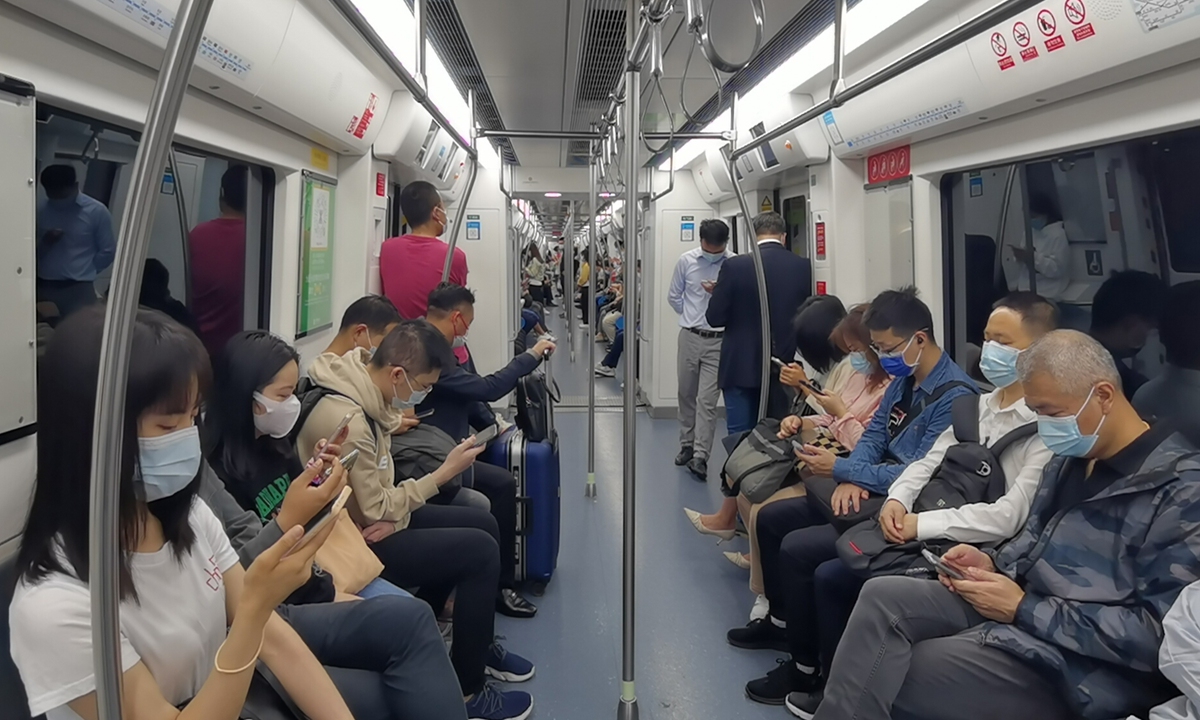
'Shenzhen speed'
Many local tech companies after a week of suspension gradually resumed production since the weekend based on strict anti-COVID measures, and they believe the impact of week-long strict measures on their production would be limited and they would catch up on reduced production soon.
Fu Wei, chief human resources officer of Ngai Kwong International Ltd. (NKI), a Shenzhen-based OEM of smart home appliances, told the Global Times on Monday that starting Monday, employees need to scan a QR code on a machine before entering the factory, which was set up by the government and can display the nucleic acid test results.
"Our production resumption rate is about 80 percent and our shipments are expected to return to normal within a month," Fu said. The factory of NKI is located in Pingshan district and resumed production on Friday. There are around 1,200 employees at the plant.
"As we have a big shipment demand, many truck drivers come and go every day, who are vulnerable to COVID-19 infection. To protect the health of employees, it is necessary to take a 7-day closure," said Fu.
Considering the long-term enterprise operation, and the safety of employees and their families, it is necessary to close down the office and factory for seven days to prevent the aggravation of the pandemic, Chen Miaoqun, marketing director of Shenzhen Kandao Technology, told the Global Times on Monday. Kandao Technology is a high-tech firm focusing on VR technology and ultra-HD video cameras.
"The one-week strict measures have an impact on production and delivery, but can be remedied and controlled by optimizing the production process and resource investment. However, if the epidemic is left unchecked without any tightening policy, it might lead to an uncontrollable situation that puts employees' health at risk," said Chen.
"Routine prevention and control measures such as 24-hour nucleic acid test negative result, and wearing masks when entering the company's office building are required. Other routines include disinfection with alcohol, and reducing mass gatherings and large meetings," said Chen.
Benny Chen Zhida, Mobile Platform Project Manager of MGI Tech, told the Global Times that the government also helped companies resume production with one-on-one measures, such as setting up a list mechanism for key enterprises in different sectors to streamline application processes for them.
As a tech hub, Shenzhen's technology also helped improve epidemic prevention efficiency.
China Mobile, jointly with Chinese drone unicorn DJI developed 5G drones, driverless vehicles to offer patrols and deliver food and other life necessities to residents in Futian district last week. China Mobile told the Global Times that the 5G anti-epidemic drones could conduct air patrol and spot residents wearing no masks and persuade them to abide by epidemic control measures, and it can also spray disinfection to improve the efficiency of epidemic work.
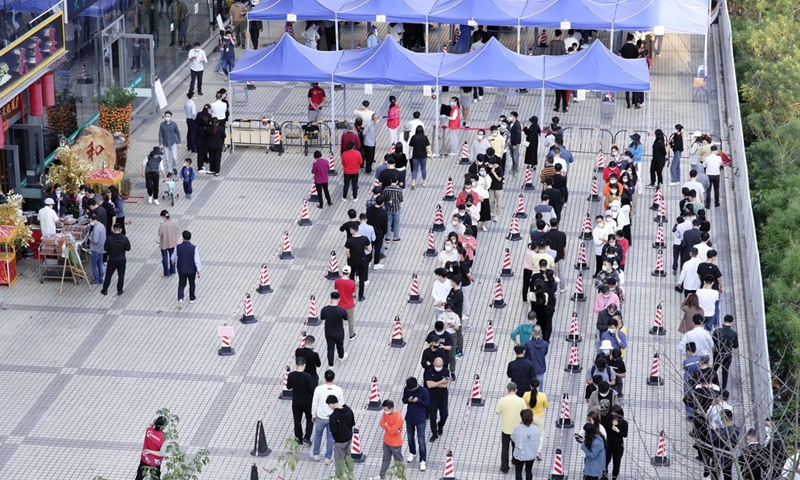
Sticking to zero-COVID policy
Lu Hongzhou, the leader of Shenzhen's anti-epidemic expert team and head of the Third People's Hospital of Shenzhen, told the Global Times on Monday that Shenzhen's most important experience is to firmly stick to a dynamic zero-COVID policy at the early stage of an outbreak.
Unlike some cities where residents can freely move before their nucleic acid testing results come out, Shenzhen required residents to stay at home to wait for the results to prevent more infections, he said.
The week-long slow life was for a rapid resumption, which generated a minimum impact on society, Lu said.
As a port city with risks of imported cases, Shenzhen has been implementing strict measures to guard against imported cases from Hong Kong, Lu said, noting that strict management of cross-border truck drivers and crackdown on illegal border crossing through land and sea were two important measures to "close the door" to imported cases.
According to the Shenzhen health authority, the city reported 884 imported COVID-19 cases since January 1, with 825 of them from Hong Kong.
Starting March 1, cross-border truck drivers from Hong Kong who enter Shenzhen were subjected to closed loop management, and they are not allowed to visit communities and public venues in the city.
According to Shenzhen media, the city's maritime law enforcement team and police have cooperated to crack down on illegal smuggling of imported frozen food and illegal crossing since February.
Multiple other cities in South China's Guangdong Province, including Zhuhai, Huizhou and Dongguan, have announced cash rewards for people who report suspected illegal crossings from Hong Kong.
Shenzhen's experience once again proved that China's dynamic zero-COVID policy was still effective against stealth Omicron, and experts said it injected more confidence to the whole country in the fight against the fresh wave of outbreak and also cheered up China' s economy as the country's fastest growing city has resumed operation in a week.
China has to firmly hold on to the zero-COVID policy at this moment, and our strategy may adjust and may reopen our borders when we get enough herd immunity through effective vaccines and COVID-19 drugs available, Lu said.
As one of the first Chinese cities to step out of the fresh wave of a domestic COVID-19 outbreak, Shenzhen's practice of unwaveringly sticking to the dynamic zero COVID-19 policy and striking a right balance between epidemic control and economy in the battle against Omicron has not only injected strong confidence in the nation's Omicron battle, but was also a powerful response to some Western media's smears and doubts of China's COVID-19 strategy which they believe was under great threat due to the fast spread of the variant.
On Monday morning, life in Shenzhen, China's fastest growing city, largely returned to normal with factories and offices reopened, and many local residents carried their desktop computers and keyboards in the subway in the morning rush hour, after the city's 17 million residents completed three rounds of nucleic acid testing.
Shenzhen reported 44 new domestically-transmitted cases on Sunday, with most found among close contacts in quarantine and two found in communities. The number of daily new positive cases found in communities has dropped from the highest 38 to one or two over a week.
The Shenzhen government announced that apart from some areas in Futian district which still reported community infections, most of the city would resume work and production activities on Monday and implement "differentiated" anti-epidemic measures for different enterprises to ensure the safety and stability of industrial and supply chains.
The awareness of "maximizing prevention and control effects at the lowest cost" has been deeply rooted in local residents as they would like to voluntarily cooperate with the implementation of dynamic zero policy in exchange for long-term social and economic development.
With most imported cases coming from neighboring Hong Kong Special Administrative Region, which is struggling with a fifth wave of outbreak, Shenzhen took resolute measures to guard against the risks of imported infections and further spread, including crackdown on illegal crossing, which set an fine example for other port cities, expert said.
Experts believe China will stick to its dynamic zero-COVID policy, and the policy is likely to be adjusted when the public reaches herd immunity through more effective vaccines and COVID-19 drugs.

Shenzhen in South China's Guangdong Province resumes subway services on March 21, 2022 after one week of restrictive policies to quickly control the spread of virus. Photo: cnsphoto
'Shenzhen speed'
Many local tech companies after a week of suspension gradually resumed production since the weekend based on strict anti-COVID measures, and they believe the impact of week-long strict measures on their production would be limited and they would catch up on reduced production soon.
Fu Wei, chief human resources officer of Ngai Kwong International Ltd. (NKI), a Shenzhen-based OEM of smart home appliances, told the Global Times on Monday that starting Monday, employees need to scan a QR code on a machine before entering the factory, which was set up by the government and can display the nucleic acid test results.
"Our production resumption rate is about 80 percent and our shipments are expected to return to normal within a month," Fu said. The factory of NKI is located in Pingshan district and resumed production on Friday. There are around 1,200 employees at the plant.
"As we have a big shipment demand, many truck drivers come and go every day, who are vulnerable to COVID-19 infection. To protect the health of employees, it is necessary to take a 7-day closure," said Fu.
Considering the long-term enterprise operation, and the safety of employees and their families, it is necessary to close down the office and factory for seven days to prevent the aggravation of the pandemic, Chen Miaoqun, marketing director of Shenzhen Kandao Technology, told the Global Times on Monday. Kandao Technology is a high-tech firm focusing on VR technology and ultra-HD video cameras.
"The one-week strict measures have an impact on production and delivery, but can be remedied and controlled by optimizing the production process and resource investment. However, if the epidemic is left unchecked without any tightening policy, it might lead to an uncontrollable situation that puts employees' health at risk," said Chen.
"Routine prevention and control measures such as 24-hour nucleic acid test negative result, and wearing masks when entering the company's office building are required. Other routines include disinfection with alcohol, and reducing mass gatherings and large meetings," said Chen.
Benny Chen Zhida, Mobile Platform Project Manager of MGI Tech, told the Global Times that the government also helped companies resume production with one-on-one measures, such as setting up a list mechanism for key enterprises in different sectors to streamline application processes for them.
As a tech hub, Shenzhen's technology also helped improve epidemic prevention efficiency.
China Mobile, jointly with Chinese drone unicorn DJI developed 5G drones, driverless vehicles to offer patrols and deliver food and other life necessities to residents in Futian district last week. China Mobile told the Global Times that the 5G anti-epidemic drones could conduct air patrol and spot residents wearing no masks and persuade them to abide by epidemic control measures, and it can also spray disinfection to improve the efficiency of epidemic work.

Residents line up for free nucleic acid testing at the special Information Port in Shenzhen's Nanshan district, South China's Guangdong Province. Shenzhen reported 66 local infections on March 13, raising the tally of cases to 432. Photo: IC
Sticking to zero-COVID policy
Lu Hongzhou, the leader of Shenzhen's anti-epidemic expert team and head of the Third People's Hospital of Shenzhen, told the Global Times on Monday that Shenzhen's most important experience is to firmly stick to a dynamic zero-COVID policy at the early stage of an outbreak.
Unlike some cities where residents can freely move before their nucleic acid testing results come out, Shenzhen required residents to stay at home to wait for the results to prevent more infections, he said.
The week-long slow life was for a rapid resumption, which generated a minimum impact on society, Lu said.
As a port city with risks of imported cases, Shenzhen has been implementing strict measures to guard against imported cases from Hong Kong, Lu said, noting that strict management of cross-border truck drivers and crackdown on illegal border crossing through land and sea were two important measures to "close the door" to imported cases.
According to the Shenzhen health authority, the city reported 884 imported COVID-19 cases since January 1, with 825 of them from Hong Kong.
Starting March 1, cross-border truck drivers from Hong Kong who enter Shenzhen were subjected to closed loop management, and they are not allowed to visit communities and public venues in the city.
According to Shenzhen media, the city's maritime law enforcement team and police have cooperated to crack down on illegal smuggling of imported frozen food and illegal crossing since February.
Multiple other cities in South China's Guangdong Province, including Zhuhai, Huizhou and Dongguan, have announced cash rewards for people who report suspected illegal crossings from Hong Kong.
Shenzhen's experience once again proved that China's dynamic zero-COVID policy was still effective against stealth Omicron, and experts said it injected more confidence to the whole country in the fight against the fresh wave of outbreak and also cheered up China' s economy as the country's fastest growing city has resumed operation in a week.
China has to firmly hold on to the zero-COVID policy at this moment, and our strategy may adjust and may reopen our borders when we get enough herd immunity through effective vaccines and COVID-19 drugs available, Lu said.
